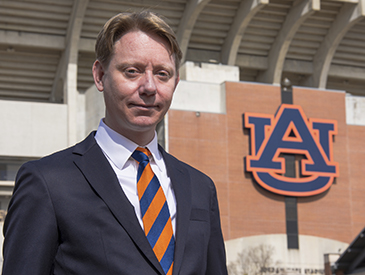In this series of posts, we sit down with a few of the plenary speakers of the 240th AAS meeting to learn more about them and their research. You can see a full schedule of their talks here, and read our other interviews here!
Professor Dennis Bodewits starts with a simple description. “Comets are made of ice and rock, and when you heat them ice is released.” Then the questions start. “How much ice does the comet contain? How is it retained? And how does it escape? What starts as simple physics questions, turns out to be complicated geology. Deep science questions can be deceptively simple.” In just a few minutes, he leaps across a wide range of comet phenomena spreading across the electromagnetic spectrum from the Infrared through to the UV and X-ray. All stemming from a simple description of comets as ice and rock.

Image Credit – Auburn University
Unique environment
Prof. Bodewits is quick to point out what unique environments comets are, and not just because of the extreme changes in temperature during their orbits. “They are geologically active objects, they evolve. It’s low gravity, and all that ice near the surface, then you fly out and you have a dense atmosphere where you have chemical reactions for about 100 km, then you get a rarefied plasma. So there is something for everybody”.
And even though they may be small compared to other solar system objects, there are still opportunities to observe them. “Because of the low gravity, they have very extended atmospheres. So instead of just a few hundred kilometers as is the case of our planets, you have a cloud of a hundred thousand, a million kilometers that is undergoing very different radiation environments at different times. So try that with your planets!” he jests, before humbly admitting to similarities with other solar system members, especially the plumes of the icy moons of Jupiter and Saturn.
“Opportunity Driven Pre-Discoveries”
Bodewits’ contributions to comet atmospheres span the electromagnetic spectrum. He describes many of his results as “opportunity driven pre-discoveries”. “We try to use atomic and molecular experiments and theory to identify diagnostics that you can then use with a telescope.” One example is work focused on the spectra of electron interactions with various gases. “For weakly active comets, electron reactions are much more important than photon reactions.” He’s part of a productive collaboration with a molecular physics laboratory in Slovakia, known for their powerful electron gun. “I just have to convince them to put in the chamber all the crazy gases.” While he might have a wish list, often practicality can be just as important as the science case. “I would love to see how electrons interact with hydrogen cyanide, but it’s very poisonous. Even something as simple as water is nasty to work with.”
Bodewits finds experiments similar to astronomical observations. “A telescope will have a generic data reduction pipeline, but never exactly what you need. You will spend a lot of time tinkering. That’s much like building your own experiment. It’s not just a mail order for a vacuum chamber, pump and electronics. It will take time to build it up. There are a lot of parallels, you will have to learn a lot.”
A diverse lab for diverse questions
And there is a lot more to learn. “Our lab [at Auburn University] is all over the place. I come from laboratory astrophysics, but we want to be close to the observing side and apply that.” His team of postdocs and graduate students range in expertise, from modeling molecules, to ground, space, and ISS based telescope observations, as well as laboratory experiments. They also have a range of backgrounds, many coming from outside the US (including Prof. Bodewits who is Dutch). “Our lab is international and we try to celebrate that. No one from Antarctica yet, but having a very diverse group is very important to us. We talk about our international experiences, which helps with being away from family, and making new friends.”
One of his postdocs, Dr. Steven Bromley, has won the Laboratory Astrophysics Division (LAD) dissertation award this year, in part due to another example of an opportunistic pre-discovery. While researching the atomic structure of gold in extremely hot plasma, Dr. Bromley took background spectra of iron and nickel, which were used to secure the gold. When iron and nickel started to be found around the plasma of comets, they found that Bromley’s earlier work in the lab was the perfect start for a new project. However, according to Bodewits, Bromley is jokingly reluctant to identify as an astronomer. “Steve jokes that he is still a physicist until he opens a .fits file.”
The plenary talk
After discussing the extreme range of environments, scientific results, and experiments designed around the study of comets and their atmospheres, there was one question left. What was the subject of Prof. Bodewits’ plenary talk? “I plan to give a general overview of atomic and molecular processes in comets that are useful for other planetary systems.” Seems deceptively simple.
Professor Dennis Bodewits will be giving the LAD talk at the 240th meeting of the American Astronomical Society, Tues. June 14th, at 4:40 PM PDT. Locations can be found in the AAS Meeting Schedule
Edited by : Sahil Hegde
Featured image credit: American Astronomical Society

